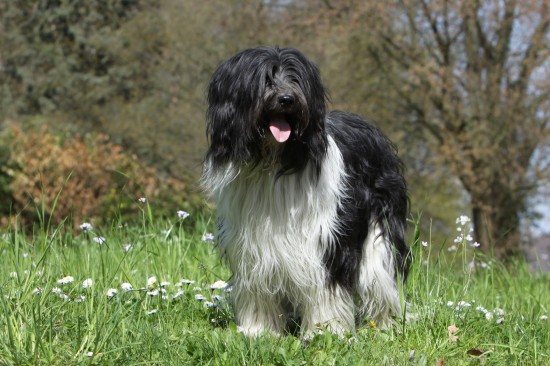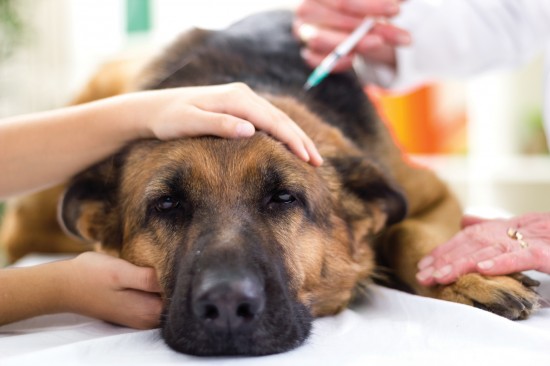

Even the most well behaved dog may find that temptation gets the better of them now and then, and this is particularly true if you happen to leave something that smells delicious sitting on the worktop or counter while you are out of the room! If your tables or counters are at eye-level with your dog or within reach of their mouths this can be a particular problem, but it is even worse if your dog is apt to jump onto the counters or tables, either to help themselves to something to eat or because this behaviour has simply never been corrected.
Dogs that get to sit on chairs and sofas a eye level with the contents of your tables are particularly likely to not really see the difference between sitting at eye level to something and taking a couple of steps up onto the work surface, and this is one blurred line that can be hard to make distinctive.
So, does your dog like to jump onto or walk onto your tables, kitchen counters or other surfaces that they should keep away from? If so, this article will teach you how to correct this behaviour.
First things first, it is important to judge objectively if the way that you manage your dog is helping to enable their behaviour, either by being inconsistent and sending them mixed signals, or by not making clear the boundaries between what is allowed and what is not.
Do not let your dog get onto the table or counters for any reason. Do not feed them up there, do not feed them from a bowl on the table while they are sitting on a chair, and don’t reward begging while you are cooking or eating by giving your dog a scrap of something from the surface you are trying to keep them away from.
If your dog is permitted to sit on your chairs and soft furnishings, restrict this to only seats that are not right in front of or that provide a clear view of the work surfaces or tables, and never let them sit at a table with you on a chair of their own while you are eating.
Before you can hope to use commands on your dog to get them off or keep them off the counters, you will need to ensure that they understand and respond to their basic commands in a variety of situations. Commands like “no,” “down,” “off,” and “leave it” are multi-usage commands that can be used in a variety of situations, so get your dog trained up to a basic level so that they know what is expected of them when you administer any of these commands to them.
It is of course important that you retain the alpha role within the household, and that you are the boss of your dog and not the other way around! If you are not the boss, your dog is unlikely to respect you in any situation, and will view your commands as a suggestion rather than a demand.
Praise your dog for compliance with your commands, and tell them off when they do not comply; if your dog still does not respond appropriately, physically remove them from the counter or table that they are on, or are eyeing up, while giving them the negative command to stop doing it.
Don’t wait until your dog makes a jump for the counter before you tell them to get down; your dog will usually be fairly transparent in their signals when they are about to jump or climb onto something, or are considering gambling over getting up when they know that they are not supposed to.
If your dog is eyeing up the counter, getting themselves lined up for a jump, or has started putting their paws up pre-emptively to jump up, tell them “no” before they make their move, and ultimately, they should soon learn that it is not worth bothering with!
You can also use diversions and deterrents to get your dog’s attention and re-direct them from the counter or table, such as using a tin can filled with dried peas that you can rattle to get their attention, and then offering a toy or other reward when they desist or get down.
Ultimately, you should be able to trust your dog not to jump up even when unsupervised, but until you get to that stage, it is important that your dog does not see any potential reward to jumping onto the counters or table, so do not leave food out unsupervised, as temptation may get the better of your dog! Keep your dog’s food and treats in a cupboard, not on a counter, and put away leftovers and wash up dirty plates right away, to keep your dog from focusing their attention on your surfaces.
When you are out, shut your dog out of rooms that have surfaces that they are apt to try to get up onto, and if you are in and your dog persists, close them out of the room in question even when you are present.
If your dog learns that this behaviour will not only fail to glean a reward but will actually lead to banishment until they can be trusted, they will find it easier to begin to associate climbing on the counters with a negative reward rather than a positive one.
 Health Issues Associated With The Shorthair Exotic
Health Issues Ass
Health Issues Associated With The Shorthair Exotic
Health Issues Ass
 The Schapendoes – The Lovely Dutch Sheepdog
The Schapendoes –
The Schapendoes – The Lovely Dutch Sheepdog
The Schapendoes –
 Are There Any Downsides To Vaccinating Dogs?
Are There Any Dow
Are There Any Downsides To Vaccinating Dogs?
Are There Any Dow
 What To Do When Things Go Wrong With Your Cats Birthing
What To Do When T
What To Do When Things Go Wrong With Your Cats Birthing
What To Do When T
 Vulnerable Native Uk Dog Breeds - The Hound Group
Vulnerable Native
Vulnerable Native Uk Dog Breeds - The Hound Group
Vulnerable Native
Copyright © 2005-2016 Pet Information All Rights Reserved
Contact us: www162date@outlook.com